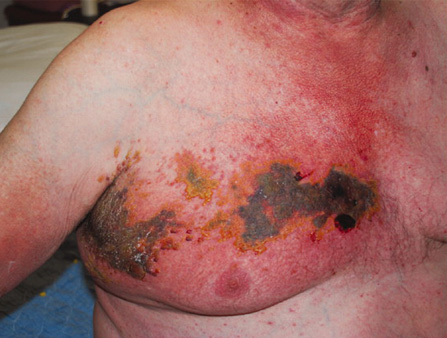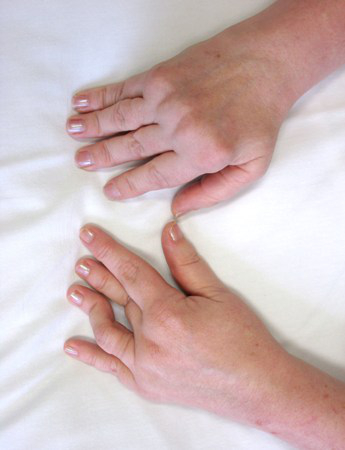Approach
Patients presenting with neurologic dysfunction of the lower extremity require a careful history and exam to localize the lesion and identify the underlying cause. The character, localization, duration, and severity of symptoms should be assessed, and clues to underlying systemic illness should be elucidated.
The aim of the exam is to identify the nerve(s) affected. Signs of systemic illness may be detected. Most compression neuropathies can be diagnosed clinically. If further investigation is needed, nerve conduction studies are usually the preferred investigation. Other investigations can be considered based on the clinical features.
Neurologic history
It is important to characterize the neurologic symptoms being experienced by the patient.[14]
Sensory symptoms: the patient should be encouraged to describe their symptoms in detail in their own words. Common descriptions include "boring," burning, stabbing, pins and needles, prickling, stinging, and sharp shooting pains. It is important to establish whether there is an associated loss of sensation, and whether it is in the same area as the paresthesias.[15] Painful paresthesias suggest an inflammatory or ischemic process such as vasculitis. Shooting pains are characteristic of nerve entrapment.
Motor symptoms: associated symptoms of motor weakness or gait abnormalities (e.g., a foot drop) should also be assessed.
Localization: the localization of the symptoms provides clues as to the affected nerve and site of compression. Nerve root compression produces symptoms in the distribution of the affected dermatome and myotome. Plexopathies produce symptoms in the distribution of multiple peripheral nerves from the plexus. Compression or injury of isolated nerves distal to the plexus produces symptoms in the distribution of the individual nerve. [Figure caption and citation for the preceding image starts]: Dermatome mapAdapted by BMJ from an image by Ralf Stephan [Citation ends].

Duration and severity: the patient should be asked whether the symptoms are constant or relapsing and remitting, and whether any symptom has progressed. A history of similar previous symptoms should be sought.
General medical history
Constitutional symptoms
Weight loss, night sweats, and/or fatigue may be present in infection, neoplastic disease, or a range of inflammatory conditions. Dry eyes or mouth may indicate Sjogren syndrome.
Skin and joint changes
Ulcers, purpura, rash, or darkening of the skin may suggest peripheral vascular disease, infection, vasculitis, monoclonal protein production, or sarcoidosis. Arthralgias, joint swelling, or stiffness may indicate a rheumatologic condition.
Past medical illnesses
It is important to establish whether the patient has any of the following underlying conditions: diabetes mellitus (level of control and complications of diabetic retinopathy and nephropathy), rheumatologic disorders (SLE, Sjogren syndrome, rheumatoid arthritis, vasculitides), cancer, or infectious disease (especially HIV).
If there is a history of diabetes mellitus or glucose-intolerant state (e.g., prediabetes), diabetic amyotrophy should be suspected.[1] A history of serious antecedent illnesses or weight changes should be sought, although the patient may have had no additional symptoms. The patient may report pain in the pelvic/thigh region that is severe and "boring." The pain can sometimes resolve in 2 to 3 weeks before weakness and muscle atrophy are noted.
Establish any history of radiation therapy to the pelvis.
Family history
A positive family history of paresthesias or sensory impairment may indicate an inherited neuropathy such as an inborn error of metabolism.
A family history of acquired diseases such as compression neuropathies, autoimmune disease, cancer, amyloidosis, or diabetes may also be present.
Social history
A history of smoking should raise suspicion of a paraneoplastic syndrome.
The presence of risk factors for HIV exposure or infection should prompt suspicion of HIV neuropathy.
Examination
Sensory system
The neurologic exam should focus in detail on the areas that correspond to the patient's symptoms, but a general neurologic exam should also be carried out to identify additional clues. The first step is to examine the sensory modalities in the lower extremities, with additional testing in the areas where the patient is reporting the paresthesias.
Light touch is tested with a cotton wisp. Temperature is tested using a cold or warm stimulus. Pinprick is tested using a single-use standard stimulus-producing tool such as a toothpick. Joint position sense is tested using the distal interphalangeal joints of the great toe or middle finger. Vibration is tested using a 128 Hz tuning fork placed at the distal interphalangeal joint of the great toe or middle finger. The exam may reveal one of the following patterns.
Sensory loss in the distribution of a single peripheral nerve indicates a peripheral mononeuropathy. Palpation of an individual peripheral nerve or specific provocative testing may elicit paresthesias, indicating a nerve entrapment syndrome. Causes of compression, including malignancy, should be considered.
Symmetric sensory loss in a glove-and-stocking distribution usually indicates a peripheral (length-dependent) polyneuropathy. This distribution is most common in diabetes and other metabolic disorders. It can also be seen in advanced cases of vasculitis.
Sensory loss in the distribution of multiple peripheral nerves indicates multiple mononeuropathies or a plexopathy. If it is painful, mononeuritis multiplex should be considered and a cause for the vasculitis sought. Mononeuritis multiplex may also indicate infection with HIV, CMV, HSV, herpes zoster virus, EBV, or leprosy.
Sensory loss in a dermatomal pattern indicates a radiculopathy. The corresponding spinal nerve is also affected and the distribution of the spinal nerve should also be tested for sensory loss. If symptoms are painful, a radiculitis due to CMV, HSV, herpes zoster virus, or EBV may be present. Provocative testing may elicit symptoms but should not be relied on in isolation to establish the diagnosis.[16][17][18]
Motor system
The presence of muscle atrophy should be noted. Weakness or atrophy in the same distribution as sensory loss indicates a mixed peripheral sensorimotor neuropathy (if the peripheral nerve distribution is affected) or involvement of a spinal root (if a dermatome and myotome are affected).
Loss of deep tendon reflexes may also be seen.
Gait should be assessed to determine whether there is a foot drop.
General exam
Fever may indicate infection.
Lymphadenopathy may indicate infection (e.g., HIV, HSV, or Lyme disease) or systemic inflammatory disease.
Diabetes should be considered if the patient is overweight or obese. Weight loss may be a sign of underlying malignancy.
Dry oral mucous membranes may indicate Sjogren syndrome.
Purpura or rash suggests infection or vasculitis. Blistering in a dermatomal pattern indicates shingles. Changes in color or thickening of the skin may indicate a monoclonal gammopathy or sarcoidosis.
Characteristic joint deformities may be present with underlying rheumatologic conditions.
Funduscopy may reveal diabetic retinopathy in a diabetic patient.[Figure caption and citation for the preceding image starts]: Severe herpes zoster in an immunocompromised patient involving dermatomes T1 and T2BMJ Case Reports 2009 [doi:10.1136/bcr.07.2008.0533] Copyright © 2009 by the BMJ Publishing Group Ltd. [Citation ends].
 [Figure caption and citation for the preceding image starts]: Rheumatoid arthritis (chronic hand deformities)From the collection of Dr Soumya Chatterjee [Citation ends].
[Figure caption and citation for the preceding image starts]: Rheumatoid arthritis (chronic hand deformities)From the collection of Dr Soumya Chatterjee [Citation ends].
Initial testing
Electromyogram (EMG)/nerve conduction studies
EMG and nerve conduction studies are the first diagnostic tests ordered.[14] EMG includes nerve conduction studies and needle exam of selected muscles, and should be directed at nerves and muscles whose involvement is suspected based on the clinical exam.
EMG can characterize the type of peripheral nerve abnormality by its electrophysiologic features (e.g., an axonal or demyelinating neuropathy). It can identify nerve entrapment syndromes and/or more proximal lesions such as radiculopathies or plexopathies. It is also used to follow recovery from neuropraxia (a transient episode of motor paralysis without sensory or autonomic dysfunction).[Figure caption and citation for the preceding image starts]: Patient undergoing electromyographyReproduced with permission from Science Photo Library [Citation ends].

Lab tests
If the clinical history, exam, or EMG and nerve conduction studies suggest the presence of systemic disease or more widespread nerve involvement (e.g., length-dependent polyneuropathy), tests such as CBC, serum BUN and creatinine, liver function testing, blood glucose testing with or without glucose tolerance testing, and thyroid function tests should be considered. If vasculitic, malignant, infectious, or inflammatory conditions are suspected, erythrocyte sedimentation rate, C-reactive protein, and complement levels should also be ordered.
Imaging
If malignancy is suspected, a chest x-ray (particularly in smokers) should be ordered as part of the malignancy workup, along with further imaging (i.e., CT scan of chest, abdomen, and pelvis) according to the suspected site and type of malignancy.
If a joint dislocation, trauma, or complications of surgery are suspected, plain films of the involved region should be ordered to exclude any orthopedic emergencies.
Additional testing
Lab tests: additional laboratory studies are ordered depending on the differential diagnosis after consideration of the history, exam, and initial testing and include:
Serum HIV enzyme-linked immunosorbent assay (ELISA) and Western blot in suspected HIV infection
Polymerase chain reaction (PCR) for varicella DNA in suspected herpes zoster infection, and for cytomegalovirus (CMV) DNA in suspected CMV infection
Viral culture of lesions or HSV PCR in suspected HSV infection
Serum Epstein-Barr virus (EBV)-specific antibodies in EBV infection
Sensitive enzyme immunoassay or immunofluorescence assay for Borrelia antibodies in suspected Lyme disease[19]
Skin smear for acid-fast bacilli in suspected leprosy
Serum antinuclear antibody (ANA), antineutrophil cytoplasmic antibodies (ANCA), complement, rheumatoid factor, and cryoglobulins in suspected vasculitis
Schirmer test and anti-60 kD (SS-A) Ro and anti-La (SS-B) in suspected Sjogren syndrome
Lumbar puncture in suspected acquired demyelinating sensorimotor polyneuropathy or other inflammatory, infectious, or malignant causes
Lymph node biopsy in suspected lymphoma
Serum and urine immunofixation in suspected amyloidosis
Anti-Hu and anti-CV2 antibodies: present in paraneoplastic immune-mediated attacks.
Imaging
Neuroimaging (MRI or CT) should be considered in any patient who is not responding to conservative treatment as expected, is displaying pain and dysfunction that appears out of proportion to the presumed mechanism of injury, or has signs or symptoms of systemic disease.
CT scan is useful for detecting retroperitoneal hemorrhages and evaluating bony structures.
MRI may be preferred for imaging soft tissues, compression sites, nerve roots, plexus, or individual named nerves.[20]
Interventional techniques
Referral to an interventionalist may be helpful in patients with suspected radiculopathy with negative or equivocal EMG, nerve conduction studies, and imaging. Guidelines by the American Society of Interventional Pain Physicians describe the evidence for the accuracy of lumbar spine diagnostic selective nerve blocks as "limited"; evidence for lumbar provocative discography is described as "fair".[21]
Use of this content is subject to our disclaimer